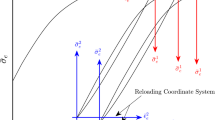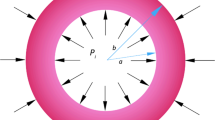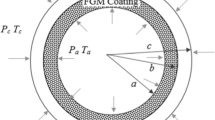Abstract
This paper describes an analytical–numerical model developed for non-stationary electro-thermo-mechanical creep response of a smart sphere made of polyvinylidene fluoride (PVDF) using Burgers’ creep model. The piezoelectric properties of the PVDF are used to control creep deformation of the sphere. Time-dependent stresses, displacements, electric potential and strains are calculated using Mendelson’s method of successive approximation. The vessel is subjected to internal and external pressures, distributed temperature fields and an applied electric potential. Two loading combinations have been considered in this study. All mechanical, thermal and piezoelectric properties are selected from the experimental data existed in the literature. All creep parameters for Burgers’ model are functions of time, temperature and stress. Their functional relationship is obtained using a nonlinear regression. Therefore, this study is a nonlinear time-dependent analysis. Total strains are assumed to be the sum of elastic, thermal, electrical and creep strains. Creep strains are time, temperature and stress dependent. Using the equations of equilibrium, compatibility, Maxwell’s equation for free electric charge and stress–strain relations, a differential equation, containing creep strains, for spherical vessel is obtained. A new semi-analytical solution has been developed to find displacement, stresses, strains and electric potential in terms of time-dependent creep strains. Creep strain rates are related to the Burgers’ creep model and current stresses with the Prandtl–Reuss relations. Using Mendelson’s method of successive approximation, the histories of electric potential, radial, circumferential and effective stresses and strains are calculated. It has been found that by applying a suitable electric potential deformation of the sphere can be controlled.























Similar content being viewed by others
Abbreviations
- u (r):
-
Radial displacement (m)
- r :
-
Radius (m)
- a, b :
-
Inner and outer radii of hollow sphere (m)
- E :
-
Elastic modulus (N/m2)
- e 33, e 13, e 11, e 12 :
-
Piezoelectric constants (C/m2)
- ∊ ii (i = 1, 2, 3):
-
Dielectric constant (C2/Nm2)
- \({\sigma_i}\,(i = r,\theta,\varphi)\) :
-
Component of stresses (N/m2)
- \({\varepsilon_{ii}}\,(i = r,\theta,\varphi)\) :
-
Component of strains
- P i :
-
Internal pressure
- P o :
-
External pressure
- τ :
-
Retardation time in Burgers’ model
- \(\Psi\) :
-
Dimensionless temperature
- \({\varLambda_r}\) :
-
Dimensionless electric displacement
- \({\dot \varepsilon_i}\,(i = r,\theta,\varphi)\) :
-
Creep strain rate (1/s)
- \({\dot \varepsilon_{e}}\) :
-
Effective creep strain rate (1/s)
- σ e :
-
Effective stress (N/m2)
- \({D_i}\,(i = r,\theta,\varphi)\) :
-
Electric displacement component (C/m2)
- ϕ (r):
-
Electric potential (W/A)
- T (r):
-
Temperature distribution function (K)
- \({\alpha_i}\,(i = r,\theta,\varphi)\) :
-
Thermal expansion coefficients (1/K)
- υ :
-
Poisson’s ratio
- E M :
-
Elastic modulus of Maxwell model
- η M :
-
Viscosity of the components of Maxwell model
- E K :
-
Elasticity of the components of the Kelvin model
- η K :
-
Viscosity of the components of the Kelvin model
- \(\Gamma\) :
-
Dimensionless electric potential
References
Dai H-L, Yang L, Zheng H-Y (2011) Magnetothermoelastic analysis of functionally graded hollow spherical structures under thermal and mechanical loads. Solid State Sci 13(2):372–378
Khoshgoftar M, Arani AG, Arefi M (2009) Thermoelastic analysis of a thick walled cylinder made of functionally graded piezoelectric material. Smart Mater Struct 18(11):115007
Arani AG, Mobarakeh MR, Shams S, Mohammadimehr M (2012) The effect of CNT volume fraction on the magneto-thermo-electro-mechanical behavior of smart nanocomposite cylinder. J Mech Sci Technol 26(8):2565–2572
Wang H, Xu Z (2010) Effect of material inhomogeneity on electromechanical behaviors of functionally graded piezoelectric spherical structures. Comput Mater Sci 48(2):440–445
Dai H-L, Jiang H-J, Yang L (2012) Time-dependent behaviors of a FGPM hollow sphere under the coupling of multi-fields. Solid State Sci 14(5):587–597
Zhou D, Kamlah M (2006) Room-temperature creep of soft PZT under static electrical and compressive stress loading. Acta Mater 54(5):1389–1396. doi:10.1016/j.actamat.2005.11.010
Loghman A, Wahab MA (1996) Creep damage simulation of thick-walled tubes using the Θ projection concept. Int J Press Vessels Pip 67(1):105–111. doi:10.1016/0308-0161(94)00175-8
Loghman A, Shokouhi N (2009) Creep damage evaluation of thick-walled spheres using a long-term creep constitutive model. J Mech Sci Technol 23(10):2577–2582. doi:10.1007/s12206-009-0631-x
Loghman A, Ghorbanpour Arani A, Amir S, Vajedi A (2010) Magnetothermoelastic creep analysis of functionally graded cylinders. Int J Press Vessels Pip 87(7):389–395. doi:10.1016/j.ijpvp.2010.05.001
Ghorbanpour Arani A, Mosallaie Barzoki AA, Kolahchi R, Mozdianfard MR, Loghman A (2011) Semi-analytical solution of time-dependent electro-thermo-mechanical creep for radially polarized piezoelectric cylinder. Comput Struct 89(15–16):1494–1502. doi:10.1016/j.compstruc.2011.05.001
Loghman A, Aleayoub SMA, Hasani Sadi M (2012) Time-dependent magnetothermoelastic creep modeling of FGM spheres using method of successive elastic solution. Appl Math Model 36(2):836–845. doi:10.1016/j.apm.2011.07.038
Loghman A, Abdollahian M, Jafarzadeh Jazi A, Arani AG (2013) Semi-analytical solution for electromagnetothermoelastic creep response of functionally graded piezoelectric rotating disk. Int J Therm Sci 65:254–266. doi:10.1016/j.ijthermalsci.2012.10.011
Ghorbanpour Arani A, Kolahchi R, Mosallaie Barzoki AA, Loghman A (2013) The effect of time-dependent creep on electro-thermo-mechanical behaviors of piezoelectric sphere using Mendelson’s method. Eur J Mech A Solids 37:318–328. doi:10.1016/j.euromechsol.2012.08.001
Xu Y, Wu Q, Lei Y, Yao F (2010) Creep behavior of bagasse fiber reinforced polymer composites. Bioresour Technol 101(9):3280–3286
Jia Y, Peng K, X-l Gong, Zhang Z (2011) Creep and recovery of polypropylene/carbon nanotube composites. Int J Plast 27(8):1239–1251
Ward IM, Sweeney J (2012) Mechanical properties of solid polymers. Wiley, New York
Tang X-G, Hou M, Zou J, Truss R, Zhu Z (2012) The creep behaviour of poly(vinylidene fluoride)/“bud-branched” nanotubes nanocomposites. Compos Sci Technol 72(14):1656–1664. doi:10.1016/j.compscitech.2012.06.025
Jalili N (2009) Piezoelectric-based vibration control: from macro to micro/nano scale systems. Springer, Berlin
Y-c Fung, Fung Y (1965) Foundations of solid mechanics, vol 351. Prentice-Hall Englewood Cliffs, NJ
Tiersten HF (1969) Linear piezoelectric plate vibrations. Springer, Berlin
Eslami M, Babaei M, Poultangari R (2005) Thermal and mechanical stresses in a functionally graded thick sphere. Int J Press Vessels Pip 82(7):522–527
Mendelson A (1968) Plasticity: theory and applications. Macmillan, New York
Acknowledgments
The authors are grateful to University of Kashan for supporting this research work.
Author information
Authors and Affiliations
Corresponding author
Additional information
Technical Editor: Marcelo A. Savi.
Appendix
Appendix
Rights and permissions
About this article
Cite this article
Loghman, A., Tourang, H. Non-stationary electro-thermo-mechanical creep response and smart deformation control of thick-walled sphere made of polyvinylidene fluoride. J Braz. Soc. Mech. Sci. Eng. 38, 2547–2561 (2016). https://doi.org/10.1007/s40430-015-0415-4
Received:
Accepted:
Published:
Issue Date:
DOI: https://doi.org/10.1007/s40430-015-0415-4




